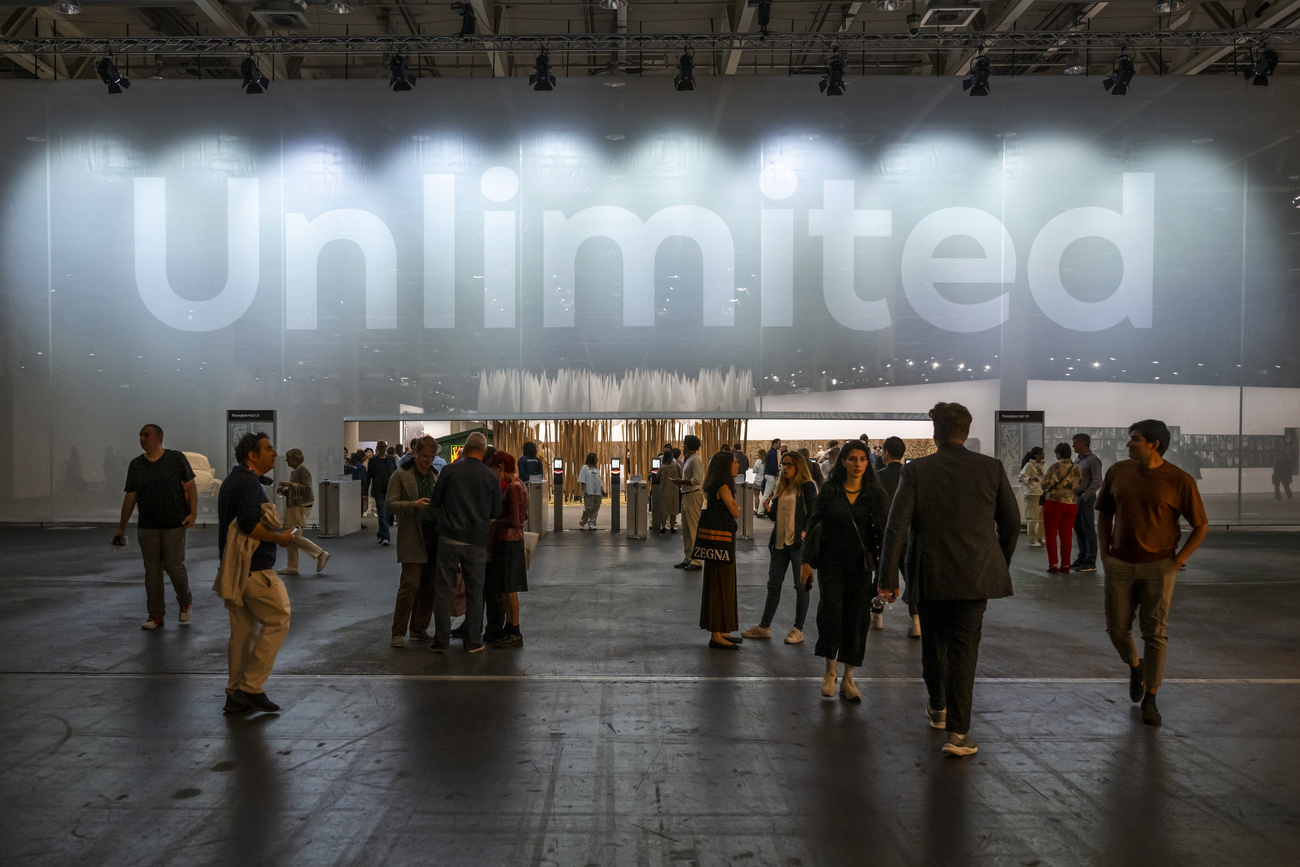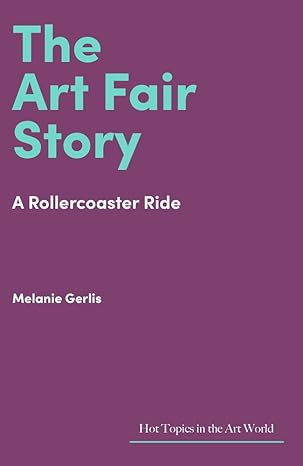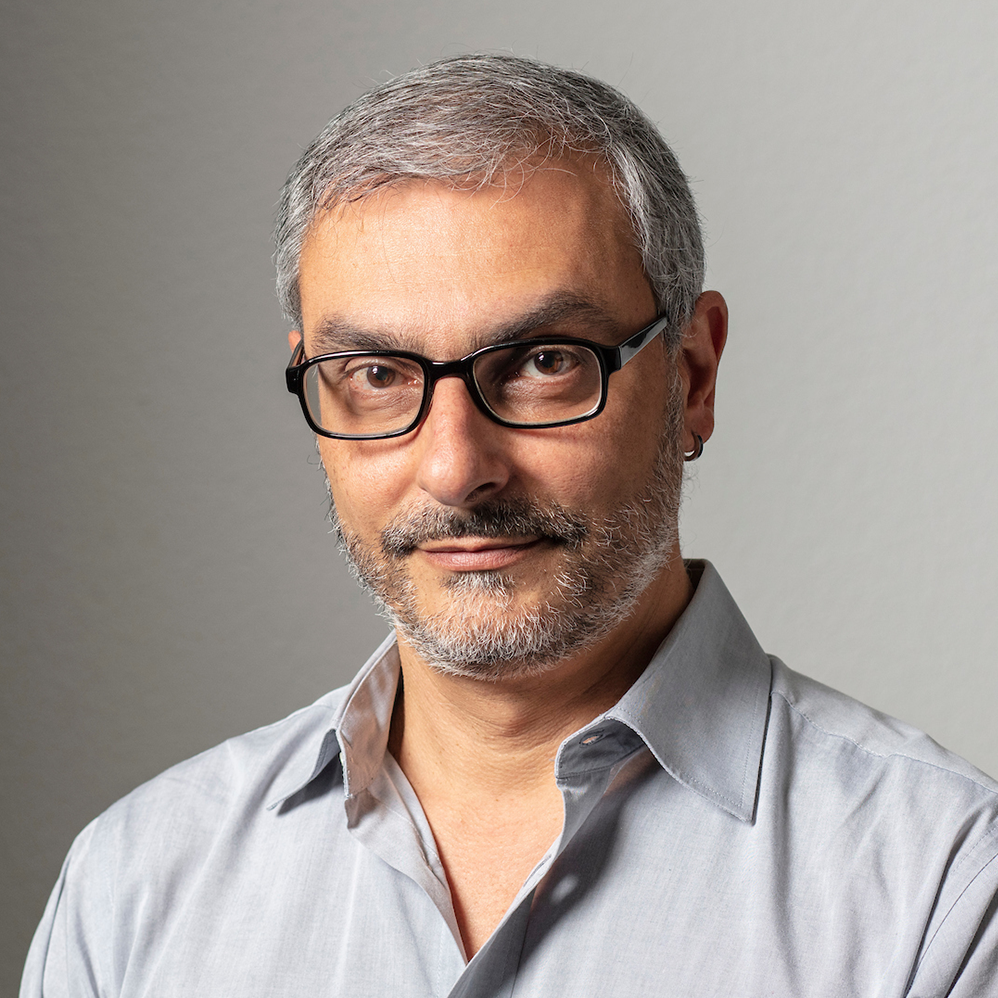
Art Basel keeps its lead as art fairs go corporate and scramble for markets

The world’s leading art fairs are being incorporated into big holdings, expanding on a planetary scale, and shaking the art market ‘ecosystem’. Are smaller fairs being squeezed out of existence?
When Noah Horowitz took the helm of Art Basel last year, no substantial changes in the fair’s structure were announced. But there was a notable change in the discourseExternal link. Unlike his predecessors, Horowitz displayed a remarkable fluency in corporate-speak, addressing market challenges and opportunities for expansion rather than expounding on artistic issues.
Yes, it is the biggest and most prestigious art fair in the world, but Art Basel is first and foremost about business. Horowitz’s job description was rebranded accordingly to reflect this. Marc Spiegler, his predecessor, ran Art Basel from 2012 to 2022 as “global director”. Horowitz is CEO, signaling a maybe not so subtle, yet substantial change of tack in how the business sees and shapes itself.
“His job is to be corporate,” says Melanie Gerlis, art market columnist for the Financial Times and The Art Newspaper. “That role didn’t exist,” she told SWI swissinfo.ch, adding that “Art Basel has done very well to put four different local people running each of their local fairs” – in Basel, Miami, Hong Kong, and Paris.
A fair too many
Long gone are the days when art fairs were the initiative of gallerists, art enthusiasts and critics, as was the case with both Art Basel and its main competitor Frieze. Similar to what happened with the fashion industry at the turn of the century, art fairs are being acquired by big holdings who massively invest in their brands as part of a strategy of global expansion.
For smaller fairs, and smaller holdings, this is not necessarily bad news. Will Ramsay, founder and CEO of Ramsay Fairs, which include the Affordable Art FairExternal link spread in 16 cities around the world, recently bought the satellite Volta art fair (Basel and New York), and hopes that Art Basel and Frieze continue to be successful.

Ramsay mentions a roster of mid-sized and regional fairs, such as ARCO Madrid and Art Brussels, to which “people are not going to fly across the Atlantic, but they are important meeting points for artists, galleries and collectors from that region”.
But the market is not big enough for everybody.
“There were 359 art fairs in 2023, and I think people are now a little bit fed up. It’s just too much,” says Gerlis.
Besides, the global art market shrank 4% in the last year to an estimated volume of $65 billion (CHF57.5 billion) – not a negligable figure, but by watching the trends, it’s no wonder that the major art fairs are consolidating.

More
Art Basel thrives despite global market slowdown
“Fairs are very expensive to run and [by going corporate] you get some economies of scale. You can make each fair cheaper if you do several. Fairs also increasingly make money through sponsorship, and naturally you get bigger sponsors if you have a big brand,” says Gerlis.
Big brands in this business are basically Art Basel and Frieze. In the last 20 years, their expansions were gradual, and their territories clearly defined. The younger Frieze set the tone in the London-New York axis, while Art Basel, sailing on its position as the oldest and most prestigious, kept on the top of the European calendar, with a foot in the USA (Miami) and another in Asia (Hong Kong).
Keeping pole position
Art Basel is owned by the MCH Group, an international live marketing company based in Basel, whose main event used to be the Baselworld watch fair. Baselworld, however, was abruptly folded in 2019 leaving the group with a big hole in its finances even before the Covid pandemic struck.
A capital injection of $44 million (with a pledge of more $40 million in the next years) from James Murdoch, scion of the media mogul Rupert Murdoch, brought MCH back to financial health, encouraging the company to adopt a more aggressive expansion strategy.
Its first move in the renewed structure was to conquer Paris: MCH killed the most traditional art fair in the French capital, FIAC (since 1974), by taking over its autumn spot at the Grand Palais. The new venture was branded Paris + par Art Basel, intended to build a differentiated character from the other Art Basel fairs.

Paris was the more high-profile move, but MCH moved on striking new partnerships to consolidate its leading position in the art fairs market, following a strategy set in place at the turn of the century.
To gain a foothold in the US market, Art Basel didn’t go for the allure of big centers like New York, Los Angeles, or Chicago; instead, it opened its second fair in Miami in 2003, benefiting from the amenable weather and virtually no competition. It has been a blasting success since then.
A decade later, big flows of capital began to flow from a booming wealthy class in Asia looking to expand and refine their investments; in a timely manner, MCH established Art Basel Hong Kong in 2013.
However, Art Basel didn’t count on the Chinese government’s crackdown on the island that significantly limited freedom and ease of working in the artistic field, a curbing of liberties which intensified after 2019. But, as noted above, art fairs are about business, and business was not much affected by the political situation, although the ambiance became more constricted.
But instead of moving its flagship Asian venue somewhere else, Art Basel decided to stay put in Hong Kong and partner with nascent and thriving art fairs in Japan (Art Week TokyoExternal link) and Singapore (S.E.A. FocusExternal link), reacting to the expansion of its main – and only serious – competitor in the field: FriezeExternal link.
Frieze framed
Frieze was originally a magazine founded by art enthusiasts in 1991, which soon became one of the most influential publications in the arts circuit. It opened its first art fair in London in 2003 as Art Basel was inaugurating its Miami show, but it found its niche by focusing exclusively on contemporary art and living artists.
Parallel to the magazine – published eight times a year – Frieze capitalised on the booming and vibrant London art scene, and soon became an obligatory stop in the world market calendar. Its success led to Frieze Masters, opened in 2012 also in London, dedicated to artworks dated from before 2000. In the same year, it launched its first fair in New York.
Frieze was becoming too big, too rich, and too expensive to continue running as an independent structure. In 2016 the American giant holding Endeavour, with businesses ranging from its major talent agency to sports marketing, acquired a 70% controlling stake in the Frieze brand, including art fairs and the magazine.
But it was only a few years later, in pandemical 2020, that the pair of original founders who still ran the company finally ceded their place to a newly-created position of CEO filled by former media executive Simon Fox.

From then on, it was all about expansion and corporate strategy: after Frieze Los Angeles (2019) came Frieze Seoul (2022), and last year it bought New York’s The Armory ShowExternal link and EXPO Chicago, which will continue to be run under their original brands.
The big fairs’ latest moves brought their territories closer. Frieze’s move to Seoul prompted Art Basel to act swiftly on the Asian corner of the planetary chessboard, while Art Basel’s muscling into Paris positioned it a bit too close to Frieze’s London stronghold, and not just geographically. In the art market calendar, Paris + opens only five days after the end of Frieze’s London show, revealing an open battle for collectors. It is also worth noting that Art Basel’s CEO Horowitz is based in Frieze’s territory of New York, and not in Basel.
What’s left for the mortals
While the big brands duel in their global heights, they are followed by a whole arts ecosystem that doesn’t limit itself to smaller and niche fairs.
For instance, when Art Basel lands in Basel, the whole art circuit comes along for the ride. Museums display their best shows of the year, Zurich galleries run an Art Weekend prior the fair to cater to the visiting collectors, and satellite fairs like Liste and Volta set up their stands. The same phenomenon can be seen in London and Los Angeles during Frieze, but Frieze has a harder time with New York, where the offer of galleries is too many and the art circuit there is trickier to get behind one fair.
“Rocky Mountain Air” (2023): kinetic art by Breakfast Studio (USA), on display at Volta art fair in Basel.
Satellite fairs are part of the big fairs’ ecosystem while also running on a parallel league of niche markets. Liste, in Basel, began in the 1990s as an initiative of young, independent galleries, and a few years ago it moved from its original quarters in the Warteck, an old brewery which still functions as a multipurpose arts center, to a huge exhibition space adjacent to Art Basel.
Some of its founders, like gallerists Peter Kilchmann and Eva Presenhuber, have made it big and have permanent stands in Art Basel. Liste became an established venue but didn’t go corporate. It is run by a foundation dedicated to its founding principles, and deeply attached to its original locus, Basel.
In the void it left in the independent scene, a new youngish initiative, Basel Social Club, started two years ago and soon became the liveliest space during Art Basel. Far from staging any serious competition to Art Basel, these independent movements “keep big art fairs on their toes”, according to Gerlis. “There is only so much they can do; people always want an alternative.”
Edited by Mark Livingston/ac

In compliance with the JTI standards
More: SWI swissinfo.ch certified by the Journalism Trust Initiative
































You can find an overview of ongoing debates with our journalists here . Please join us!
If you want to start a conversation about a topic raised in this article or want to report factual errors, email us at english@swissinfo.ch.